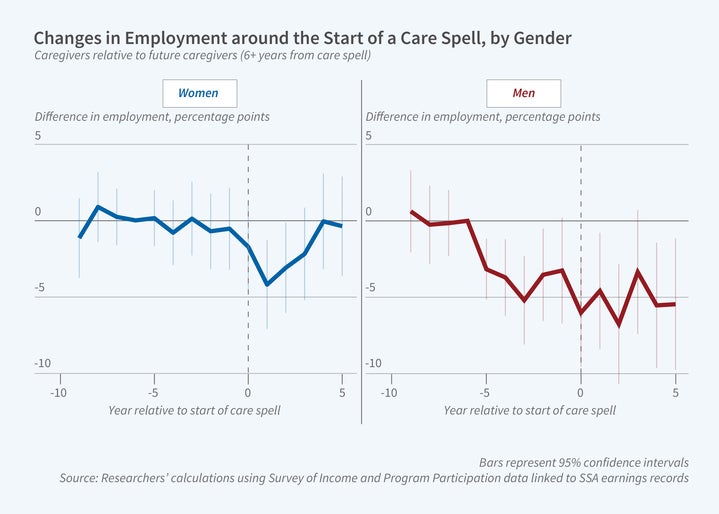How Does Caregiving Affect Labor Supply?

The need for long-term, nonacute caregiving is projected to rise significantly in coming decades. The number of Americans ages 65 and older is expected to double by 2050 and approximately one-third of adults in this age range report multiple functional limitations. Much of the growing demand for long-term care is met by unpaid family caregivers, more than half of whom are also formally employed. Caregiving demands may lead some caregivers to exit the labor force or work at reduced hours and wages, affecting their economic well-being.
In Caregiving and Labor Supply: New Evidence from Administrative Data (NBER Working Paper 31450), researchers Nicole Maestas, Matt Messel, and Yulya Truskinovsky examine this relationship, with a particular focus on the evolution of labor supply before and after the start of caregiving.
One long-standing challenge in exploring this issue is that caregivers may differ from non-caregivers — for example, in their degree of attachment to the labor force. This raises the possibility that differences in labor supply between caregivers and non-caregivers might reflect unobserved differences between the groups rather than the direct effect of caregiving.
To address this concern, the authors first identify individuals in the Survey of Income and Program Participation (SIPP) who report providing unpaid care to family and friends. Next, they link these data to Social Security Administration earnings records, allowing them to observe annual earnings for many years before and after individuals begin serving as caregivers. Finally, to create a comparable control group of non-caregivers, they match caregivers to other SIPP respondents with identical demographic characteristics and similar earnings and employment trajectories at least a decade before caregiving begins. They also employ an alternative approach where caregivers who are six or more years away from this role (“future caregivers”) serve as the control group.
Before women start providing care, there is no difference in their employment or earnings trajectories and those of non-caregivers or future caregivers. However, in the three years after women begin providing care, the employment of caregivers falls by 2.7 percentage points (4 percent) relative to the employment of future caregivers, or by 2.1 percentage points relative to non-caregivers. The employment gap between caregivers and comparison groups narrows three to five years after care begins. The average annual earnings of female caregivers fall by nearly $1,000 (4 percent) in the first three years after caregiving begins, relative to the earnings of future caregivers, and remains about $600 lower in years three to five, although the longer-term difference is not statistically significant.
For men, the picture is quite different. The employment and earnings of male caregivers begin to decline five or more years before men begin to provide unpaid care, relative to the trajectories of male non-caregivers and future caregivers. After they begin providing care, male caregivers experience a further employment decline of 3.7 percentage points (5 percent) relative to the control group of future caregivers. Male caregivers stay out of the labor force longer than do female caregivers, as the employment gap between male caregivers and their control groups persists in years three to five rather than narrows as seen for female caregivers.
The authors find that the effects are larger for women who become caregivers at younger ages, who are more likely to be caring for a disabled child or parent than for a spouse. They also find that the effect of caregiving on work for highly educated women is more similar to the effect of caregiving on work for men.
In sum, “male caregivers of all ages experience large downward swings in earnings and employment well before the start of a caregiving episode, which are of similar magnitude to the direct impact of the onset of caregiving on outcomes. … Conversely, the onset of caregiving leads to an immediate — and significant — reduction in earnings and employment for women who take on these roles.” The authors conclude, “We hypothesize that for potential caregivers with the strongest labor force attachment (men and highly educated women), family health needs interact with and exacerbate planned or unplanned interruptions in employment or earnings trajectories. This suggests that family caregiving needs, which will only increase in the future, have the potential to turn temporary labor market shocks into long term exit from the labor force.”
The research reported herein was performed pursuant to grant RDR18000003 from the US Social Security Administration (SSA) funded as part of the Retirement and Disability Research Consortium. The opinions and conclusions expressed are solely those of the author(s) and do not represent the opinions or policy of SSA, any agency of the federal government, or NBER. Neither the United States Government nor any agency thereof, nor any of their employees, makes any warranty, express or implied, or assumes any legal liability or responsibility for the accuracy, completeness, or usefulness of the contents of this report. Reference herein to any specific commercial product, process or service by trade name, trademark, manufacturer, or otherwise does not necessarily constitute or imply endorsement, recommendation or favoring by the United States Government or any agency thereof. This project was also supported by grant number T32HS026128 from the Agency for Healthcare Research and Quality. The content is solely the responsibility of the authors and does not necessarily represent the official views of the Agency for Healthcare Research and Quality. The views expressed herein are those of the authors and do not necessarily reflect the views of the National Bureau of Economic Research


